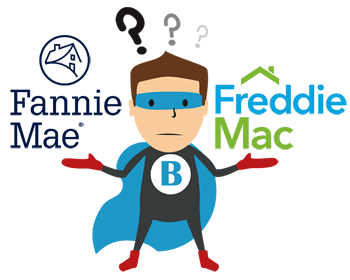
What are Fannie Mae and Freddie Mac and what do they do?
In the wide universe of American home loans, there are several institutions that shape the real estate market. Among the best known are Fannie Mae and Freddie Mac, two companies with government support that facilitate the purchase of a home. Because of its importance, we have to let you know their creation and what they do to help you.
Article content
- Origin and purpose of Fannie Mae
- Origin and purpose of Freddie Mac
- Differences between FNMA and FHLMC
- Final thoughts
Origin and purpose of Fannie Mae
Like the FHA, Fannie Mae appeared during the Great Depression (1938) and was promoted by President Franklin D. Roosevelt. Its original name is Federal National Mortgage Association (FNMA) and arises from the Federal Home Loan Bank Act, with the intention of promoting the possibility of more American citizens having access to a home.
Fannie Mae's main role began with the buying mortgages from commercial banks larger so that they could offer more mortgage loans. In this operation, this agency grouped the debts in the form of securities backed by mortgages. It then proceeded to sell these derivative instruments to investors, pension funds, and hedge funds.
 On the other hand, the FNMA does not function as an organization that lends you money to obtain a home, but rather as an intermediary. As one of the largest mortgage loan buyers in the secondary market, you can back and guarantee these mortgages through financial entities that are attached to their services.
On the other hand, the FNMA does not function as an organization that lends you money to obtain a home, but rather as an intermediary. As one of the largest mortgage loan buyers in the secondary market, you can back and guarantee these mortgages through financial entities that are attached to their services.
The conversion of Fannie Mae into a company happened in 1968, as Congress did not want to continue funding it as an agency. Instead of using the taxes for their operations, they decided to make a public offering to raise capital through shareholders. Although it is sponsored by the government, its investors own this company.
Origin and purpose of Freddie Mac
Known as FHLMC (Federal Home Loan Mortgage Corp), this government agency was created during the presidency of Richard Nixon, in 1970. At that time, Congress supported its start-up so that it could compete with the FNMA. The main difference from this one is that Freddie Mac could buy any type of mortgage.
The FHMCL is one of the results of enacting the Emergency Home Finance Act 1970. The purpose of its application was to expand the secondary market for mortgage loans and, at the same time, reduce risk interest rates for financial institutions. Eventually, this body would separate from the government to become a GSE (Government Sponsored Enterprise).
Considered a shareholder-run financial services corporation, Freddie Mac backs nearly 80% of all mortgages in America. Like Fannie Mae, her work is not focused on giving you a mortgage loan, but on creating liquidity conditions for banks, credit unions and savings entities.
The scheme for the purchase of mortgages is similar to the FNMA: grouping several credits and then selling them as mortgage-backed securities (MBS). These instruments work like bonds that generate dividends for those who decide to invest in them. Not only are they secured by a pool of mortgages, they are exchanged on the secondary market and serve to leverage the real estate business.
Differences between FNMA and FHLMC
Although these institutions arose at different times or for different purposes, both they fulfill the same function within the real estate market. Since they are GSEs and people have the possibility to buy shares to participate in them, the most relevant differences are not many. Basically they are reduced to 2:
- Fannie Mae Offers Home Ready Loan (Ready House), for which applicants cannot have an income higher than 80% of the average of the area where they reside. While, Freddie Mac puts the Home Possible program at your fingertips (Hogar Posible), which asks applicants to live in a home and not have a salary higher than the average for the area where they are.
- The FNMA creates the conditions of greater access to credit by buying the mortgages of the major commercial banks. Instead, the FHLMC does so by acquiring these financing commitments from smaller or local entities they have less exposure.
Final thoughts
While some think that Fannie Mae and Freddie Mac were partly responsible for the 2008 crisis, others believe that they are mechanisms that facilitate the acquisition of property in the United States. Whatever the case, they are important institutions that can help you get a mortgage with fewer requirements than the largest commercial banks.
When it comes to shopping for home loans, there are many options available if you have a decent credit history and a stable income. There is no doubt that the FNMA and FHMCL are interesting alternatives when your personal finances are not the best. But if you want other options in the mortgage category, you can find them in the Business Blog comparator.
Leave a Reply
You must be logged in to post a comment.


Tambien puedes leer: